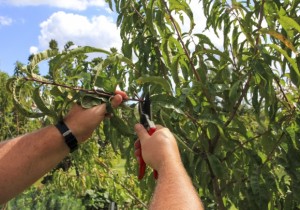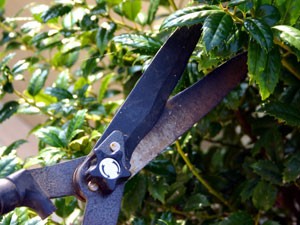It’s the question that gardeners have wrestled with for as long as gardening has existed. It’s lead to everything from books and blogs to debate, discussion and lines being drawn in the sand—erm, soil—over what is, to be sure, one of the most volatile topics in gardening today—
To prune or nor to prune, that is the question!
 Now, for some gardeners, this may seem like a no-brainer. Pruning is an absolutely necessary part of the process, they say, and without it, elements such as rot, decay and sickness set in, creating an overall inferior plant.
Now, for some gardeners, this may seem like a no-brainer. Pruning is an absolutely necessary part of the process, they say, and without it, elements such as rot, decay and sickness set in, creating an overall inferior plant.
For others, it’s likewise just as clear as day—pruning is a gardening sin, alters the natural state of a plant’s development, and interferes with the “all-natural” vibe that’s so precious for so many gardens and gardeners today.
Two distinct viewpoints—is there one distinct, clear answer?
In a word—no. In more than a word—see below:
To Prune…
 If you talk to most gardeners who operate in even a quasi-professional capacity, chances are they’ll tell you that pruning is, again, absolutely essential. The idea of pruning is to snip and remove the dead or decaying parts of a plant, add those elements to either your green waste for recycling or else reuse those parts in your own home-made mulch, and spare your plant from any potential diseases or elements of decay that might set in by leaving it unpruned. Does this work? Yes. Does this alter the natural state of your plant? That depends on what you mean by “natural,” and how far and literally you’re prepared to take that term. All in all, this is certainly the more professionally-accepted option of the two.
If you talk to most gardeners who operate in even a quasi-professional capacity, chances are they’ll tell you that pruning is, again, absolutely essential. The idea of pruning is to snip and remove the dead or decaying parts of a plant, add those elements to either your green waste for recycling or else reuse those parts in your own home-made mulch, and spare your plant from any potential diseases or elements of decay that might set in by leaving it unpruned. Does this work? Yes. Does this alter the natural state of your plant? That depends on what you mean by “natural,” and how far and literally you’re prepared to take that term. All in all, this is certainly the more professionally-accepted option of the two.
…Or Not to Prune
 Those who are anti-pruning generally take the “all-natural” angle of gardening to what is either “the next level” or “the extreme,” depending on how you want to view it. Obviously Mother Nature doesn’t snip here and tuck there, so disallowing any pruning can create a garden that’s less a well-manicured series of bushes and flowers and more of a real approximation of nature in minuscule. That being said, that “nature in minuscule” does also include all the disease, rotting and decaying that comes with it. Mother Nature’s beautiful, but every beauty has her uglier sides. Then again, perhaps you’re so in love with the Earth and nature that even this rot and decay can worm its way into your heart? If you want a truly “all-natural experience,” this might be the way to go.
Those who are anti-pruning generally take the “all-natural” angle of gardening to what is either “the next level” or “the extreme,” depending on how you want to view it. Obviously Mother Nature doesn’t snip here and tuck there, so disallowing any pruning can create a garden that’s less a well-manicured series of bushes and flowers and more of a real approximation of nature in minuscule. That being said, that “nature in minuscule” does also include all the disease, rotting and decaying that comes with it. Mother Nature’s beautiful, but every beauty has her uglier sides. Then again, perhaps you’re so in love with the Earth and nature that even this rot and decay can worm its way into your heart? If you want a truly “all-natural experience,” this might be the way to go.
So, it really comes down to what you prefer in a garden—a well-manicured, professional-looking work of art in a garden that looks right of painting, artificiality and all, or an all-nature celebration of Mother Nature with all her sights and smells, worms, rot and all?
That is the Question!